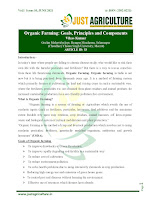Photoperiodism, Short day plants, Long day plants & Day neutral plants and Phytochrome
Or
"The response of the plants to the photoperiod, expressed in the form of flowering is also called as photoperiodism."
- The phenomenon of photoperiodism was first discovered by Garner and Allard (1920).
- Depending upon the duration of photoperiod, the plants are classified into three categories.
1. Short Day Plants
2. Long Day Plants
3. Day Neutral Plants
1. Short day plants:- These plants require a relatively short day light period (usually 8-10 hours) and a continuous dark period of about 14-16 hours for subsequent flowering. These plants are also known as long-night plants because for flowering of these plants a certain minimum uninterrupted dark period in total 24 hours is necessary. If the dark period is less than a certain time period there will be no flowering. E.g. Rice, Coffee, Soybean, Maryland Mammoth Tobacco, Chenopodium album and Chrysanthemum etc.
2. Long day plants:- These plants require longer day light period (usually 14-16 hours) in a 24 hours for subsequent flowering. Such type of plants require either a relatively small period of darkness or no darkness at all. The flowering in long day plants is inhabited not because of short light periods but because of too long dark period that's why such plants are also called Short Night Plants. E.g. Wheat, Barley, Oat, Cabbage, Sugar-beet and Spinach, Lettuce and generally Rabi Crops.
3. Day Neutral Plants:- These plants flower in all photoperiod ranging from 5 hours to 24 hours continuous exposure. Although, such plants are generally unaffected by the day length. E.g. Tomato, cotton, sunflower, cucumber, peas and certain varieties of tobacco.
Phytochrome
- It is observed that a brief exposure with red light during critical dark period inhibits flowering in a short day plant and this inhibitory effect can be reversed by a subsequent exposure with far-red light.
- Similarly, prolongation of the critical light period over the interruption of the dark period stimulates flowering in long day plants.
- This inhibition of flowering in short day plant and stimulation of flowering in long day plants involves the operation of proteinaceous pigment called phytochrome.
- Phytochrome is present in roots, coleoptiles, stems, cotyledons petioles, leaf blades, vegetative buds flower tissues and developing fruits of higher plants.
- Phytochrome pigment present in two different forms red light absorbing form which is known as Pr and dfar light absorbing form which is known as Pfr.
Agricultural Plant Physiology: C3 , C4, & CAM Plants
The photosynthesis occurring in absence of light is called dark reaction. It occurs in the stroma of chloroplast. . The dark reactions can be occurs also in the presence of light. In dark reaction, the sugars are synthesized from CO2. The process is called carbon fixation or carbon assimilation. In dark reaction two types of cyclic reactions occur -
1. Calvin cycle or C3 cycle
2. Hatch and Slack pathway or C4 cycle
🌾C3 plants:- It is a cyclic reaction occurrs in the dark phase of photosynthesis. In this reaction, CO2 is converted into sugars. The Calvin cycle was first observed by Melvin Calvin in chlorella, unicellular green algae. Calvin was awarded Nobel Prize for this work in 1961. Since the first stable compound in Calvin cycle is a 3 carbon compound (3 phosphoglyceric acid), the cycle is also called as C3 cycle.
1. Found in all photosynthetic plants.
2. Plants that use the cycle can be hydrophytic, mesophytic and xerophytic.
3. Photoactive Stomata
4. High rate of Photorespiration
5. Normal Leaf anatomy
6. For the synthesis of glucose molecule or 6CO2 fixation:12 NADPH and 18 ATPs are required.
7. Single CO2 fixation occurs
8. Primary CO2 atmospheric acceptor RUBP
9. First stable product 3PGA
10. First enzyme involved RUBISCO
11. Carbon dioxide compensation point: 30-70PPM
12. Examples - Rice, Whet, barley, Cotton, Potato, Tobacco, Soyabean , Pea etc.
🌿C4 Plants:- It is the alternate pathway of C3 cycle to fix CO2. In this cycle, the first formed stable compound is a 4 carbon compound viz., oxaloacetic acid. Hence it is called C4 cycle. The path way is also called as Hatch and Slack cycle. The C4 plants show a different type of leaf anatomy. In the leaves of these plants, the vascular bundles are surrounded by bundle sheath of larger parenchymatous cells. This peculiar anatomy of leaves of C4 plants is called Kranz anatomy.
1. Only in tropical plants.
2. Plants that use the cycle can be mesophytic
3. Photoactive Stomata
4. Photorespiration: less or negligible
5. Kranz anatomy
6. 12 NADPH and 30 ATPs are required.
7. First stable product OAA (Oxalo acetic acid)
8. First enzyme involved PEP Carboxylase
9. Examples:- Maize, Sorghum, Sugarcane, Pearlmillet, Cyperus etc.
🌵CAM Plants:- CAM is a reaction occurrs in the dark phase of photosynthesis in the plants of Family Crassulaceae. It is a CO2 fixation process wherein, the first product is malic acid. The plants exhibiting CAM cycle are called CAM plants. e.g., Bryophyllum, Opuntia, Orchid and Pine apple families.
1. Specially in succulents growing under semi arid condition.
2. Plants that use the cycle can be xerophytic
3. Scotoactive Stomata
4. Photorespiration: least or negligible
5. Xeromorphic
6. 12 NADPH and 39 ATPs are required.
7. Double carbon dioxide fixation
8. First stable product OAA (Oxalo acetic acid)
9. First enzyme involved PEP Carboxylase
Thank You
Vikas Kashyap:)












0 Comments